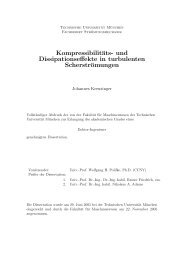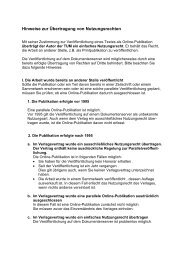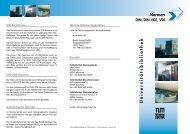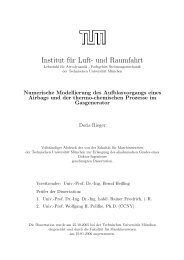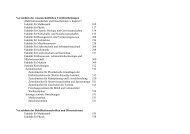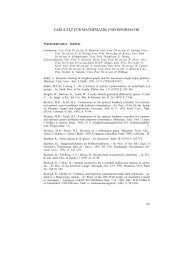LES of shock wave / turbulent boundary layer interaction
LES of shock wave / turbulent boundary layer interaction
LES of shock wave / turbulent boundary layer interaction
You also want an ePaper? Increase the reach of your titles
YUMPU automatically turns print PDFs into web optimized ePapers that Google loves.
5<br />
Figure 1.2: Essential flow phenomena in compression ramp flows (for explanations<br />
see text on page 4)<br />
ment: amplification <strong>of</strong> the vorticity mode, generation <strong>of</strong> acoustic and<br />
entropy modes from the <strong>interaction</strong>, and turbulence pumping by <strong>shock</strong><br />
oscillations.<br />
Near the decompression corner the flow experiences a short region<br />
<strong>of</strong> favorable pressure gradient, as well as stabilizing effects <strong>of</strong> convex<br />
curvature. It is found that the expansion <strong>wave</strong> / <strong>boundary</strong> <strong>layer</strong> <strong>interaction</strong><br />
reduces the intensity <strong>of</strong> <strong>turbulent</strong> fluctuations (Smits & Wood,<br />
1985; Zheltovodov & Yakovlev, 1986). The experimentally determined<br />
temperature/velocity correlation coefficient <strong>of</strong> about 0.8 supporting the<br />
validity <strong>of</strong> the strong Reynolds analogy (SRA) <strong>of</strong> Morkovin (1962) in<br />
this region. Furthermore, a rapid distortion analysis demonstrated reasonable<br />
agreement with the experimental results. Knight et al. (2003)<br />
provide a review <strong>of</strong> the compressible <strong>turbulent</strong> <strong>boundary</strong> <strong>layer</strong>s in the<br />
compression/expansion corners.<br />
The unsteadiness <strong>of</strong> the <strong>shock</strong> is an important feature <strong>of</strong> separated<br />
flows. It was observed for different configurations: two-dimensional and<br />
swept corner <strong>interaction</strong>s and wall-mounted blunt fins. The <strong>shock</strong> foot<br />
motion can be described by two primary components: a low frequency,



